I have to come right out and say it – this is the largest European moth’s caterpillar. (Does that mean it is the largest European caterpillar?)
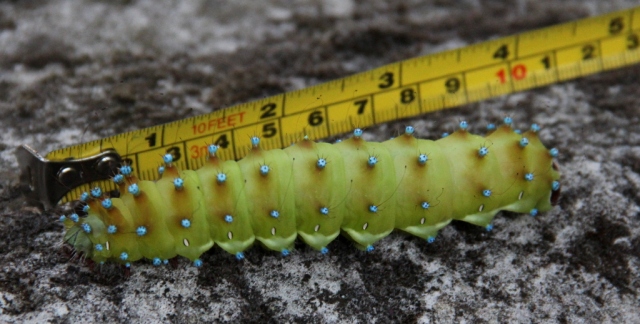
A couple of evenings ago I went out into the back garden to do a bit of watering and as I reached to turn on the hose I noticed something crawling along the wall in front of my eyes. I did a double take as I had never seen anything like it before. A few shouts and the whole household was roused to come and see what I had found.
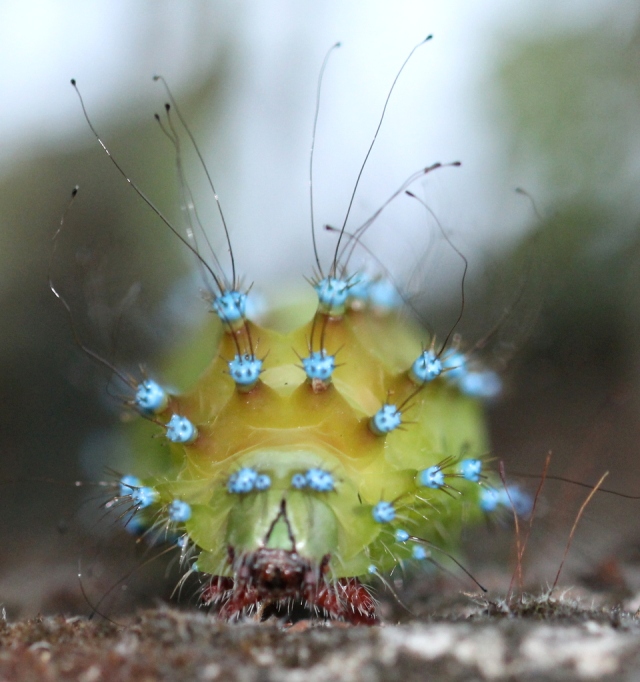
It was not only its size that was astounding, 10 cm., but the blue baubles made it look very unreal.
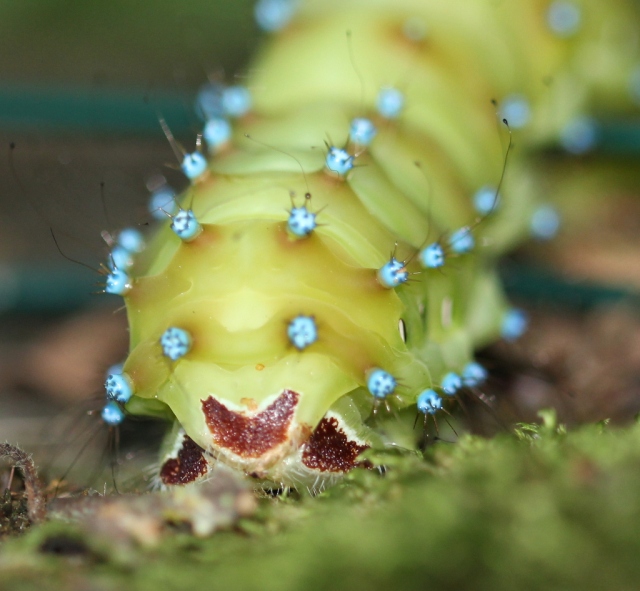
I wasn’t able to get good pictures because of the poor light and the steady progress it was making along the wall.
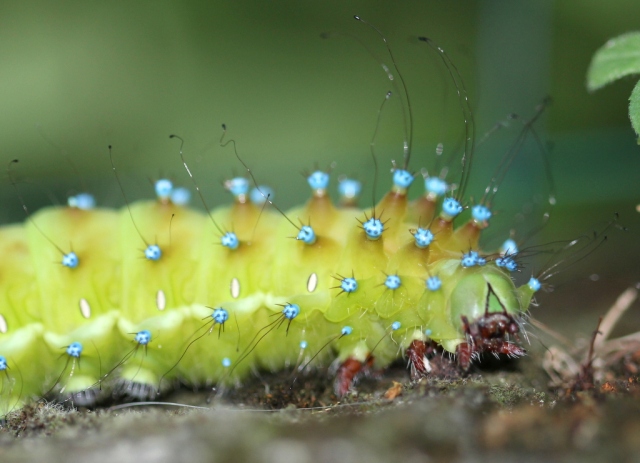
I had a good idea what it might be as I had seen photographs of the huge moths that can be seen in the area.
For pictures of the adult moth and more information from Wikipedia please click on the links. The moths fly from April to June so I presume the caterpillars must over winter in pupal form and my caterpillar did seem dead set on getting somewhere quickly, so it must have been searching for a convenient place to over winter.
The caterpillars feed on tree leaves and it appeared to have dropped out of our apricot tree. The next day I started to search for leaves with large holes or even whole branches denuded! However, when I looked up into the branches of the apricot tree I found something else.
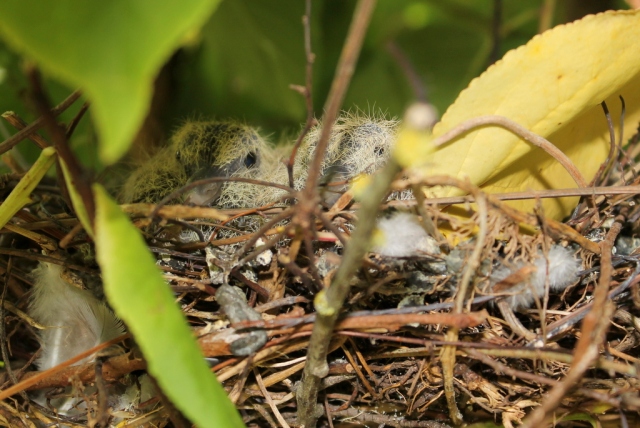
The apricot tree was already being used by the Ring doves to nest in and I hadn’t noticed. Not the most beautiful babies, perhaps I could label them “cute” if I was in a charitable mood. I had to give up on my search for traces of the caterpillar’s passing.

Fabulous and evocative photos of the Giant Peacock moth caterpillar.
LikeLike
Thank you, I wonder where he was going to pupate? I did not have time to follow him and the light was starting to fade anyway.
LikeLike
THAT is a stunner, Amelia – and I would have rushed out to see it too. Your next mission is to photo the adult (no pressure). D
LikeLike
I have exactly the same idea. I had hope to look for night-flying moths this year but did not get round to it as I was in the UK for longer than I had planned. Now I really have an incentive for next year.
LikeLike
Wow! That’s an incredible creature! I love your photos – looks like he’s in some kind of weird party get-up! True, those baby birds are not exactly pretty, but they’ll make up for it when they grow up.
LikeLike
He does look dressed-up, not at all what we consider natural colours.
LikeLike
Only its mother could love a baby pigeon…. P.
LikeLike
So true!
LikeLike
Quite a beastie! :-O
LikeLike
Now I have to get the adult next year! I won’t need a Macro lens.
LikeLike
Ha ha. I doubt it! 😀
LikeLike
Nice images!
LikeLike
Thank you, but the light was poor and I felt I could have done better with more light and I did not want to disturb it.
LikeLike
Still awesome!
LikeLike
It looks to me like you’ve found proof that aliens do live among us. That caterpillar is truly out of this world.
LikeLike
I agree, I found the blue baubles really weird.
LikeLike
I like the blue spots on that caterpillar! I don’t think we have that one here.
LikeLike
I have never seen blue spots on a caterpillar and I don’t think you’ll find this in the States.
LikeLike
It’s enormous (the caterpillar). What weird looking ornaments on its fleshy body. I wonder how it avoids getting eaten (probably eats some toxic plant or other). What fun to find some baby ring doves!
LikeLike
I’ve been meaning to look for some night flying moths so this gives me some impetus to get myself organised next year.
LikeLike
Very cool creature!
LikeLike
It did have quite an aloof allure as it continued along the wall disdainful of the excitement it was creating.
LikeLike
The pictures were so neat bet he was amazing looking in person!
LikeLike
‘Unreal’ is right Amelia! A spectacular specimen.
LikeLike
My husband actually saw the moth itself some years ago before we were living here permanently and a friend even took a photograph of the moth, so now I would love to see the actual moth for myself.
LikeLike
I found one of these babies trundling through my hallway – it was certainly easy to spot – quite magnificent and so BIG.
I also got a picture of what could be its parents in flagrante delicto – posted under ‘Creatures Great and Small’.
Hope you get to see it in adult form – bet you on the lookout for the cocoon?
LikeLike
You should have put a link into that post, they are great photos and they are the same caterpillars so you have been lucky enough to see the adults too. Have you any idea where the caterpillars are likely to pupate?
LikeLike
What an extraordinary creature with those blue baubles. And the ring dove babies do look cute; just a little bit, anyway.
LikeLike
The ring doves have already become sleeker and lost their tufty baby feathers. It is amazing how quickly they grow. The parents have become very tame for a long time and they don’t mind K taking photographs of the babies.
LikeLike
That’s lovely that they are so content in your company.
LikeLike
Perhaps too content, one of them walked in the patio doors the other day. My daughter says they keep on looking in the window as if they are checking the place over for their winter quarters.
LikeLike
How funny. What do they normally do in the winter?
LikeLike
Stay outside!
LikeLike
😀
LikeLike
Caterpillars, spiders, frogs, and mice are truly opportunities to appear really manly for your wife or girlfriend without encountering significant risk…the best of both worlds. I loved the photos I have never seen anything like that.
LikeLike
I’m pretty good with most things. I love frogs and mice but I’m am not so keen on spiders – I think it is their eight eyes, six too many for me. Amelia
LikeLike
Pauline commented on the baby collar’d doves…
but I’m far more interested in that caterpillar, Amelia…
the illustration in Chinery just doesn’t do it justice…
it is fantastic… especially with the turquoise blue spots!
We get the adults [and probably the caterpillars here, too]…
I have a fore and hind wing in the French copy of Chinery…
the former was found in Grand Pressigny, by the Marie….
I hope the bat was happy with the meal!
The front rib of that wing is as hard as iron and very stiff…
just one of Natures wonders, construction like that!!
You’ll find a lot of pix on our blog entry “The Night Visitors”…
[http://le-moulin-de-la-forge.blogspot.fr/2013/05/the-night-visitors.html]
including some taken through the window as it watched us watching it!!
It has a most amazing furry body!
LikeLike
Those are fantastic photographs. You wrote that you took them in the morning light but the post is night visitors. When do you think is a good time to see them? I really would like try to see them next year. The other moths were gorgeous too. We often see the Jersey Tiger Moth but that is day flying and we have seen it while we have been out on walks during the day.
LikeLike
They normally come to the windows at night…
the ‘morning’ pictures are very early…
courtesy of the cats wanting their morning meal….
so I am usually up and about around 6:30 / 7:00 AM!!
So the pictures taken in the morning are of the one that stayed the night on the window sill / window frame.
However, it did allow natural light pictures rather than flash!
I moved it to somewhere more secluded and shady after I’d taken the pix…
both to protect it from the sun and the birds…
the cats aren’t bothered by it…
the inquisitive female, RonRon, sat and stared at it through the window as it looked in…
but didn’t venture out!
She normally eats any moth that ventures in…
phwaaa! All those scales…
We get Garden, Jersey, Ruby and now Cream-spot Tigers here…
Garden and Jersey are both out during the day.
LikeLike
What a beauty!!! Haven’t met one of these guys up to now but wouldn’t mind one bit. Lucky girl! And the baby pigeons are very sweet too.
LikeLike
At least if you see one now you can tell people you have just seen the caterpillar of the Saturnia pyri moth instead of a bright green, 10 centimetre caterpillar wearing bright blue baubles. Sounds more convincing.
LikeLike
🙂 exactly!
LikeLike
What a wonderful creature. Now just imagine if they were the size of a small car…!
LikeLike
Fabulous pics of a fabulous critter Amelia (and cute chicks too!). I recently photographed a very similar caterpillar – our only native member of the Saturnia family, the emperor moth S.pavonia. It looks the same but its spots are barbie pink instead of blue.
LikeLike
I saw that! Your photograph was superb. It must be pupating time.
LikeLike
What a magnificent creature! I would love to see one. As for the doves, I know little about birds so am surprised to see them nesting this late.
LikeLike
PS absolutely love that second picture of the caterpillar.
LikeLike